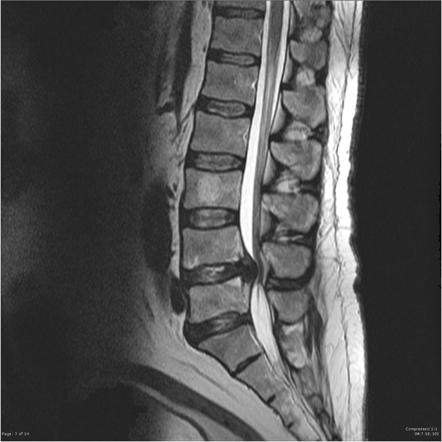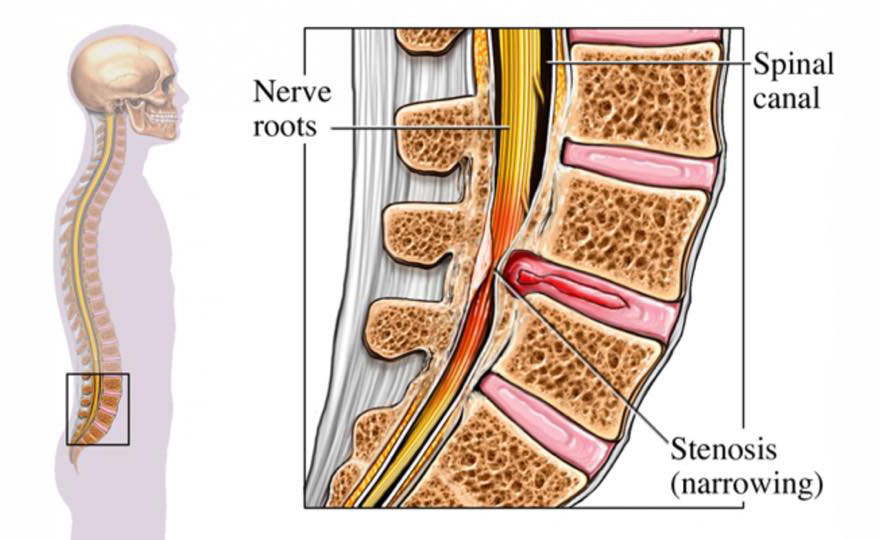Common Conditions
Spinal stenosis
Spinal stenosis is a condition that occurs when the spinal canal – the space within the spine that houses the spinal cord and nerves – becomes narrowed. This narrowing can place pressure on the spinal cord and the nerves that travel through the spine, potentially causing pain and other symptoms further down the body.

What causes spinal stenosis?
Spinal stenosis can develop at any level due to various factors, including:
- Age-related changes: Natural wear and tear over time commonly leads to the thickening of ligaments or the growth of bone spurs.
- Facet joint arthritis: Conditions including osteoarthritis, facet joint ganglions and occasional rheumatoid arthritis can contribute to inflammation and stenosis in the spine.
- Herniated discs: Discs in the spine may bulge or rupture, pressing on nearby nerves.
- Trauma or injury: Severe spinal damage from trauma can result in a traumatic narrowing of the spinal canal.
- Spondylolisthesis: When a vertebra slips forward on the one below the spinal canal can become narrowed.
- Congenital factors: Some individuals are born with a narrower spinal canal, which can predispose them to this condition.
- Combination of the above.
Common symptoms of spinal stenosis
The symptoms of spinal stenosis can vary based on the severity and location of the narrowing but often include:
- Pain: This may occur in the neck, lower back, or typically in legs. Pain is often aggravated during exercise. Sometimes this is referred to as neurogenic claudication.
- Numbness or tingling: Sensations may be felt in the arms, hands, legs, or feet.
- Weakness: Some people experience difficulty with walking, standing, or coordination.
- Cramping: Muscle spasms or cramping in the legs are common.
- Severe symptoms: In advanced cases, there may be a loss of bladder or bowel control, which requires urgent medical attention.
Diagnosis of spinal stenosis
Diagnosis of spinal stenosis begins with a review of your symptoms, such as back or neck pain, numbness, tingling, or weakness in the arms or legs, and whether these symptoms worsen with standing or walking. A physical examination is used to assess spinal motion, reflexes, muscle strength, and sensation.
Imaging studies are essential for confirming spinal stenosis. These may include:
- MRI scans to visualise narrowing of the spinal canal and compression of nerves.
- CT scans, sometimes with contrast (CT myelogram), for detailed views of spinal bones and nerve pathways.
- X-rays to detect bone spurs, disc degeneration, or spinal alignment issues.
These tests help determine the location and severity of the narrowing and guide treatment decisions.

Management of spinal stenosis
Treatment options for spinal stenosis can include a combination of approaches:
- Physical therapy: Exercises can help improve strength, flexibility, and mobility.
- Medications: Anti-inflammatory drugs and pain relievers may help reduce discomfort.
- Injections: Corticosteroid injections can target inflammation and relieve pressure on the nerves.
- Lifestyle adjustments: Maintaining a healthy weight and practicing good posture can reduce stress on the spine.
- Surgical options: In cases where symptoms are severe (especially with abnormal neurology), or do not respond to other treatments, surgery may be necessary to relieve pressure on the spinal cord and nerves. Typically, a laminectomy is performed which may or may not be associated with a fusion.


